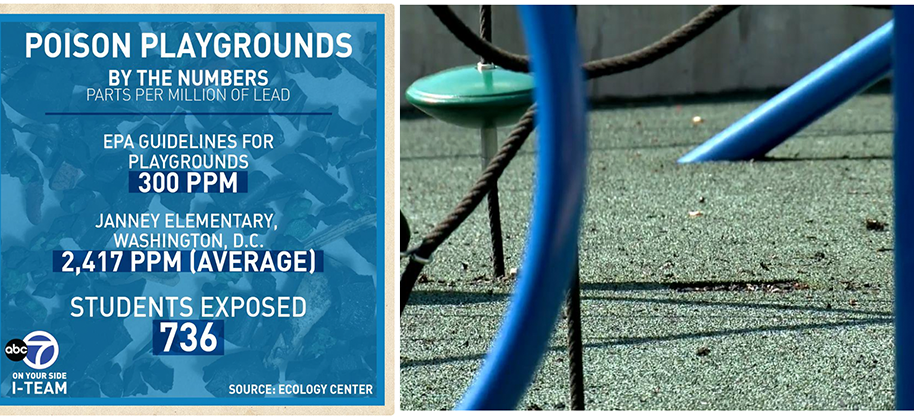Poured in Place (PIP) playground surfaces have become increasingly popular for children’s play areas. You know the ones. They are bouncy and brightly-colored, oftentimes with playful patterns. These surfaces are touted as a win-win. Children have a soft, molded rubber surface on which to land while playing and industry has an end-use for old, worn-out car and truck tires. But, Ecology Center research has shown that the surfaces meant to keep kids safe from falls could be exposing them to lead.
On July 29, the Ecology Center participated in a community scientific forum in Washington, D.C. to discuss a range of concerns about the ongoing use of crumb rubbers. At the forum, the Ecology Center presented lead testing results from four playgrounds in D.C.
One of the four playgrounds from which the Ecology Center tested surface samples was the Janney Elementary School playground in Washington, D.C. The results showed a wide range of lead levels in the rubber shred, also known as crumb rubber, ranging from non-detect to thousands of ppm. Some of the lead levels found by the Ecology Center are 100 times higher than what is allowed in children’s products. Third-party lab results validated the findings of high levels of lead, with results showing 7,079 and 6,514 parts per million (ppm) in two individual tire shred samples. The Ecology Center collaborated with the Safe Healthy Playing Fields Coalition to collect samples. Full report and the analysis is available here.

As a result of these findings, the City of Washington, D.C. performed additional testing through a private laboratory. High levels of lead were found at three local playgrounds: Aiton Elementary School, Cardozo Education Campus, and Thomson Elementary School. The playgrounds have been closed indefinitely. The City is currently working on testing all 257 playgrounds that have the PIP recycled rubber surface and expects to have testing completed by January.
The Ecology Center was originally contacted by Safe Healthy Playing Fields, a group of concerned parents, who have been calling for the elimination of PIP and synthetic turf (which has a crumb rubber base). They advocate for engineered wood fiber for playgrounds and pesticide-free playfields. The group cites concerns over:
-
Toxicity (Lead exposure and cancer risk),
-
Temperature (PIP surfaces can reach over 150 degrees Fahrenheit), and
-
Hardness (PIP surfaces lose the ability to cushion falls over time and as heat rises).
Lead has historically been added during the tire manufacturing process step called vulcanization to improve elasticity. Tires can also pick up lead from lead wheel weights and leaded paint on highway strips. Additionally, tires are known to contain polycyclic aromatic hydrocarbons (PAHs), a group of chemicals linked to many health concerns. Dibenzopyrenes, a highly carcinogenic group of PAHs, have been found in automobile tires. A recent study showed that PAH levels in dust were 4-5 times higher on PIP playgrounds compared to playgrounds with uncovered bare ground.
Crumb rubber from shredded tires does not stay attached to the molded PIP playground surfaces. Particles break off, can stick to the bottoms of children’s shoes, and get in their clothing, hair, and mouths. Dust from the crumb rubber can be inhaled or get on skin and clothes. Children are especially vulnerable to the harmful effects of lead and PAHs due to their developing bodies and their frequent hand to mouth activity. There is no safe level of lead exposure, a known neurotoxin.
The U.S. Environmental Protection Agency historically promoted crumb rubber as a safe way to recycle tires. The agency recently released a report, Synthetic Turf Tire Crumb Rubber Research Report, that concluded exposure risks from toxic chemicals, including lead, within artificial turf were low. On August 6, 2019, The Ecology Center along with Public Employees for Environmental Responsibility (PEER) filed a legal complaint charging that EPA’s report contains inaccurate, incomplete, and unreliable information and must be retracted.


